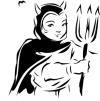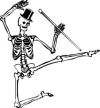Ag Comhaireamh Daoine i gCultacha Oíche Shamhna (Vaimpírí, Gúil, srl.) Posted by róislín on Oct 12, 2012 in Irish Language
(le Róislín)
So, the title of this blog means “Counting People in Halloween Costumes,” but of course there’s always the possibility that these beings are simply that, neacha (beings). I’ll leave that idirdhealú to you, na léitheoirí, and I’ll just proceed with how we would count them, lenite them, eclipse them, and otherwise grammatically manipulate them. For counting people, we use uimhreacha pearsanta (personal numbers).
You might remember na bunuimhreacha iad féin from other blogs or from general usage: amháin, dhá, trí, ceithre, cúig, sé, seacht, ocht, naoi, deich. Remember, the bunuimhreacha are not the same as the maoluimhreacha, which start out with “a haon, a dó, a trí, a ceathair, a cúig,” although there is lots of overlap.
Most of the uimhreacha pearsanta are similar to the basic numbers, with the exception of “beirt” (two). They are as follows, for 1 through 10: (duine) amháin, beirt, triúr, ceathrar, cúigear, seisear, seachtar, ochtar, naonúr, deichniúr. These personal numbers are usually followed by the noun indicating the type of person (or being) you’re counting, as in “beirt mhac” (two sons), “beirt bhan” (two women), “triúr mac” (three sons), “ceathrar ban” (four women), etc.
There are several approaches to what form of the noun should be used after the personal number. I favor the genitive plural, for reasons discussed in the blogs listed below. The two other systems use the nominative singular and the nominative plural. At any rate, this blog will proceed with the foirm sa tuiseal ginideach, uimhir iolra (genitive plural), except, of course, for the number “one,” by default. In this regard, these forms are noticeably different from the ordinary rules for nouns after numbers, which stay singular, as in “dhá bhosca” (lit. two box) and “trí mhadra” (lit. three dog).
So here goes, ghoulies, ghosties, long-leggity beasties and all
gúl amháin
beirt thaibhsí, likewise, beirt ghúl, etc., but note below that we’ll have “triúr taibhsí.” There is lenition after “beirt” but not after the other personal numbers.
triúr zombaithe, also triúr gúl, triúr taibhsí, srl.
ceathrar gruagach
cúigear ban sí (not that I’ve ever heard of more than one existing in one time and place). Note that “ban” is the genitive plural of “bean.” “Mná” is the nominative plural (or subject form) and is probably more widely seen, for example,on restroom doors.
seisear diabhal
seachtar vaimpírí OR seachtar deamhan fola, lit. demons of blood. If you prefer the emotion-draining type of vampire, as opposed to the blood-sucking ones, you could say “*seachtar sí-vaimpí,” but admittedly this could lead to some confusion with an dá chomhainm eile connected to “sí.” The two homonyms of “sí” are 1) “sí” as in fairy mound (originally spelled “síodh” [shee] before the 1950s spelling reform) and 2) “sí,” as in English “she” (the feminine pronoun). The third “sí,” presented here, is my Irish variation of the English prefix “psy-,” which is used in the relatively newish English word “psy-vamp.” For “psy-vamp,” I’ve also shortened the word “vampire,” just as has been done in English, so the plural form is “vaimpí.” In Irish, all the words for “psychology” (síceolaíocht), “psychiatry” (síceatracht), “psyche” (sícé [SHEE-kyay]), etc., have lost the silent “p” that we have inherited from Greek, so I’ve followed suit here.
ochtar cnámharlach [KNAWV-ur-lukh], eight skeletons. I might be going out on a limb here, considering skeletons to be human-type beings, but I’m thinking of the singing, dancing, Day-of-the-Dead types. Surely they deserve to be considered animate and humanish, even if not technically beo (alive). If you think otherwise, please let me know–but I imagine most readers will make no bones about it. If we considered the cnámharlaigh to simply be inanimate objects, we’d say “ocht gcnámharlach” for “eight skeletons,” using eclipsis (as in “ocht mbosca,” eight boxes)
naonúr mumaithe, or if you prefer the more specific reference to desiccation, naonúr seargán (two words for “mummy,” why not?)
deichniúr neach mothaitheach
In the spirit of the opening of Harry Potter, that is, approaching Bonfire Night, we could add: Mugal amháin, beirt Mhugal [bertch WUG-ul], triúr Mugal, srl. I’m not sure, though, if many people will be trick-or-treating dressed up as a Muggle. After all, cén chaoi a mbeadh fhios againn?
For the “long-leggity beasties” of yore, I finally decided on “alltáiníní cosfhada,” after checking out a number of words for “beast” in Irish. A number? Yes, they include 1) ainmhí (also means “animal” in general, too benign-sounding for present purposes), 2) beithíoch (usually means domestic four-footed, actually “hoofed,” animals, like cows, also too benign), 3) brúid (more emphasis on brutishness than scariness), and 4) péist, a true cognate, via “piast,” but too likely to be associated with worms, for which it is one of the primary words in Irish (péist thalún, earthworm; minphéist, mealworm; leithphéist, flatworm). And saying that a worm is “long-legged,” or in our folksy jargon “long-leggity,” seems useless, to say the least, and absurd, at the extreme. Maybe in some Dalídhreach osréalach, but not in our nuts-and-bolts folklore creature-scape!
“Long-leggity” suggests to me more of a two-legged scary creature on long, stilt-like legs. So I used “alltán” (monster, wild person), with the diminutive “-ín,” to give it the “beastie” as opposed to “beast” sense. But I’m open to bhur moltaí, if you have other suggestions for “long-leggity beasties.”
So we could count: alltáinín cosfhada amháin, beirt alltáiníní chosfhada, triúr alltáiníní cosfhada, srl.
As for the possibility of “long-leggity beastie” buachaillí [Long-leggity Beastie Boys], I’ll leave that to samhlaíocht lucht an phunc-rac, an rapcheoil, agus an cheoil hip hap. But I couldn’t resist the connection!
And finally, I’m still wondering if one could dress up as a beathfhórsa ([BA-OR-suh] life force). And if so, should we count them (na beathfhórsaí) as people, using the uimhreacha pearsanta? In that case, they would be counted as: beathfhórsa amháin, beirt bheathfhórsaí, triúr beathfhórsaí, srl. Smaoineamh suimiúil!
Or should we consider na beathfhórsaí as things/objects? If that’s the situation, then we’d have: beathfhórsa amháin (no change), dhá bheathfhórsa (“dhá” instead of “beirt“), trí bheathfhórsa (“trí” instead of “triúr“), srl. Bhur smaointe? SGF, Róislín
Gluais: Dalídhreach, a “Dalíscape” (as in tírdhreach, landscape, etc.); gruagach, goblin; lucht, crowd, group; mothaitheach, sentient; neach, a being; osréalach, surrealistic; samhlaíocht, imagination; taibhse, ghost
For previous discussions on “uimhreacha pearsanta,” you might want to check out these previous blogs:
https://blogs.transparent.com/irish/na-huimhreacha-pearsanta-ar-leanuint/ (10 Eanáir 2011)
https://blogs.transparent.com/irish/na-huimhreacha-pearsanta-i-ngaeilge/ (6 Eanáir 2011)

Build vocabulary, practice pronunciation, and more with Transparent Language Online. Available anytime, anywhere, on any device.






Comments:
Mise Áine:
@ I’m not sure, though, if many people will be trick-or-treating dressed up as a Muggle. After all, cén chaoi a mbeadh fhios againn?
Ceist mhaith! ..:-)
róislín:
@Mise Áine Sea, ceist shuimiúil! GRMA as scríobh isteach. Dála an scéil, tá sé ar intinn agam (le tamall anuas) scríobh faoi na fleiscíní mar a mhol tú, ach tá cúpla úbhar eile le déanamh agam roimhe sin. Ach roimh i bhfad!
Al:
Beirt is often wrote on my sons homework copy ,I always thought it stood for two in the counting of people ?